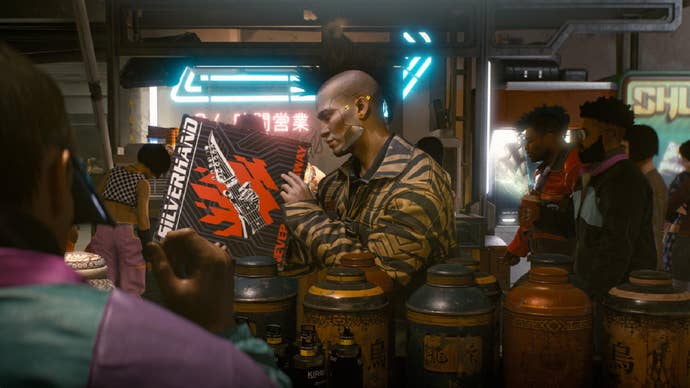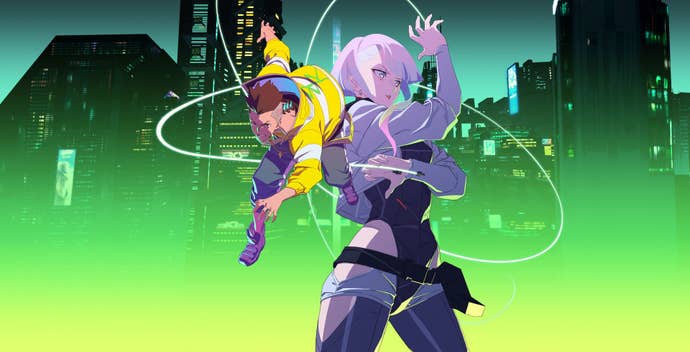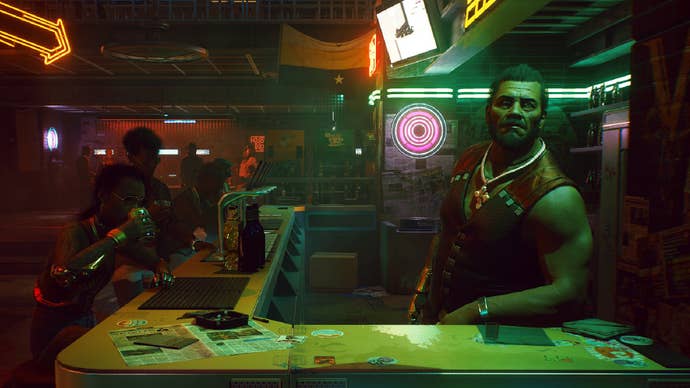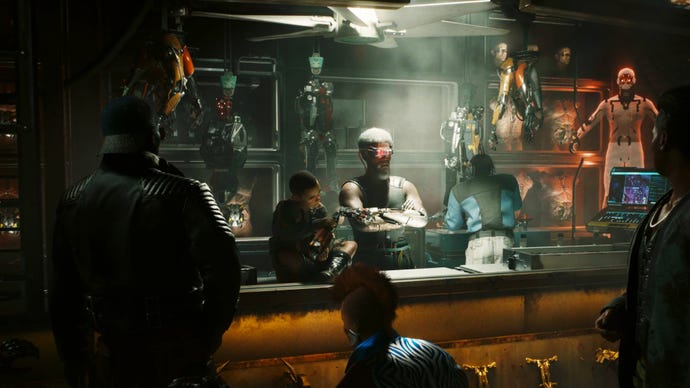Charting Cyberpunk 2077’s journey from sighs to highs through the eyes of its modding community
“I watched in the wings to see whether it would wither on the vine or bear fruit.”
“Having played the original TTRPG, way back in the stone ages, I was stoked to hear that they were making the game with Mike Pondsmith's guidance,” Cyberpunk 2077 modder Darkcopse tells me.
“However, I've been entrenched in the tech world for too many decades to be an early adopter of anything. So, when it was released, I read the reviews and sighed. But, I watched in the wings to see whether it would wither on the vine or bear fruit. After patch 1.31 [arrived], it was clear CDPR was working hard to deliver on [its] promises and I took my first dip into Night City, as did many.”
“Despite the rough release, I'm glad that CDPR’s continued to work on the game all this time,” fellow modder DJ_Kovrik says, “and it was nice to see how quite a few ideas that appeared in the community and [were] implemented by modders – such as vehicle purchasing, dynamic minimap zoom, pocket radio and many others – eventually appeared in the game itself [via updates].”
“After playing through each lifepath, I found a modding community that was eager to close [the] gaps and the bugs in its gameplay and extend its potential,” Darkcopse continues. “To be fair, a lot of the new gameplay functionality that was introduced by mods was already in the game's code in some form or another. Just not implemented. These modders dug in and made this ‘cut content’ visible and functional. It definitely propped up the game to give CDPR the time needed to polish these features.”
One of these early mods that brought a feature some players had long desired to the game was ‘Virtual Atelier’. It was a means of making items and vehicles (thanks to DJ_Kovrik) available to buy via websites on the game’s computers – and it continues to add new storefronts on a regular basis. It was also the genesis of Darkcopse’s modding exploits with the game.
“For Cyberpunk 2077, getting all the clothing items was a ridiculous grind, and I couldn't escape the fact that in 2077 I couldn't order anything online,” they recall. “So, I found the Nexus Mods site and the Virtual Atelier mod. I started creating stores that had everything, but there were bugs and functionality missing that I wanted [to include], to make it more immersive. So, I made some modifications, as I had done with several mods for my own usage.
“As a programmer by profession, this was almost as fun as the game itself. I then reached out to the inheritor of that mod, DJ_Kovrik, to see if they wanted to incorporate them in the source. We did some collaborations on a few features and fixes, then he refactored the whole mod, making it so much better than before and incorporating my changes.”
.jpg?width=690&quality=70&format=jpg&auto=webp)
Since then, Darkcopse has created both ‘Missing Persons - Fixer's Hidden Gems’ and its newer, Phantom Liberty-focused sequel ‘Pacifica Typhoon - Dogtown's Hidden Gems’. Based around making the process of hunting down the randomly placed little secrets, discoveries, and lore-filled info shards that dot the base game’s world, these mods are designed from the ground up for the “terminal completionist” – something the modder happily admits to being themselves.
“On the forums, I would see people's various ‘look what I found’ posts and nearly all of them [were] these hidden gems... and someone would inevitably point this out,” they explain. “After Pokémon-ing them all, I thought it would be cool to create [a] mod that would help players find all of these hidden gems in the most immersive way I could.”
Darkcopse says both mods wouldn’t have come about without another member of the game’s modding community, the brilliantly-named keanuWheeze - the modder who famously added a fully fleshed out Metro System to the game back in 2021. They credit ‘Corrupt NCPD’ - a mod from keanuWheeze which gives V the ability to bribe Night City’s cops - with really showing them the way in terms of how to set up their Hidden Gems mods.
“After dissecting how to send phone messages, I had to create a quest tracking system that would load at runtime and maintain state between different game saves,” they reveal. “It was then a matter of figuring out what triggered certain gems to spawn or not, and writing the messages themselves, trying [to] incorporate the [NPC sender’s] demeanour and vernacular.”

Both mods rely on a number of incredibly useful framework mods that form the basis of, and help bring to life, a lot of Cyberpunk’s bigger mods. “Cyber Engine Tweaks, redscript, RED4ext, ArchiveXL, TweakXL, and WolvenKit are amazing,” the modder explains. “These core mods don't overlap to a great degree, and provide modders with a suite of tools to tackle a variety of tasks. You could – and some do – use all these tools in the creation of a single mod.”
As DJ_Kovrik puts it, these framework mods are what “define Cyberpunk 2077 modding as we see it today”, and the community that produced them certainly hasn’t stopped modding the game since they arrived. “It's been three years since the game [was] released, however a lot of modders are still pretty active with things like modding guides and tutorials,” the modder explains, “not to mention that the authors of all [of those] base mods and tools are still actively supporting them with the release of each new patch for the game, and that is really amazing.”
A lot of these veteran modders are members of the Cyberpunk 2077 Modding Community Discord server, which Darkcopse credits for hosting “a wealth of information on Cyberpunk 2077 modding”, as well as plenty of “senior modders [who] are amazingly encouraging and helpful to new modders”. The fact that kind of help is available to those who seek it out looks to have been more important with Cyberpunk 2077, given the game’s pretty unique - and very well-documented - post-release journey.
DJ_Kovrik cites Cyberpunk: Edgerunners, in particular, as having “increased the number of players who not only want to install mods, but are also interested in how mods are created”, in addition to the boost it gave to the number of folks just playing the base game.
“There were a lot of new mod authors at that time and many of them are still active nowadays,” they say, adding: “[Patch 2.0], which largely reworked a lot of the game systems, improved all the positivity around the game even further. So, it's a bit sad that Phantom Liberty was the only expansion, just when the game got a solid foundation for adding new content.”

What awaited those new prospective modders was, and remains, an interesting learning curve – especially if you want to create something fairly complex. “The whole process of mod creation can be quite complicated, because there are a lot of tools, and each has its own purpose that allows [you] to mod certain parts of the game or engine,” DJ_Kovrik outlines.
“So, finding the right tool might take some time, especially for beginner modders. Plus, we are also limited with [regards to] the functionality which [is] exposed to scripts and can be used for modding,” they add. “A lot of the game’s core parts are hidden inside the engine and not available for calling from scripts, so using such things will require more advanced programming skills.”
Creating new quests in the game is “still quite difficult to modify at the moment”, per DJ_Kovrik. It’s something that a few modders, such as Deceptious, have been working on. New quests are rare right now, then, but Darkcopse thinks they could become more common in the future.
“Quest-based mods are always fewer in number than bugfix, cheat, QOL, immersion, and especially cosmetic mods for virtually any game,” they point out. “Typically, quests touch many areas of a game's engine. This requires the collective knowledge of how to manipulate those areas - the [Cyberpunk] 2077 modding community is especially collaborative in that regard - then a plan on how to tie all of those together with something engaging to make the journey worth it. This is why some of the most elaborate and expansive quest-based game mods are for games that are many years old. I think Cyberpunk 2077 has the potential to serve as a platform for these kinds of fan-based expansions...given time.”

Looking to the future, it’ll also be interesting to see what the community can do with Cyberpunk’s sequel, currently codenamed Project Orion, the development of which has only only properly gotten underway at CDPR since we rolled over into 2024.
“I'm not very familiar with Unreal Engine modding so it's hard to tell what we can expect [modding-wise], but I want to mention that it'd be great to see further cooperation and communication between CD Projekt and the modding scene,” DJ_Kovrik says. “Redmod’s release was definitely a step in the right direction, even though its functionality is a bit limited compared to all [the] fan-made tools, so hopefully CDPR won't stop here and will continue to support modders.”
In terms of gameplay, both modders have a few things in mind they’d like to see - aside from the kinds of in-depth storytelling and interesting characters that we’ve all come to expect from CDPR. Darkcopse feels that “the illusion of a world that operates regardless to the player and doesn't just spawn around them” is important, while DJ_Kovrik mentions “lifepaths that affect the story and gameplay, and maybe more in-game activities like Gwent from The Witcher 3.” “It would also be great to have more customization options for gear and vehicles,” the latter adds.
“As far as I know, a few people in the community have tried to implement something like this for Cyberpunk 2077, but with the current modding capabilities it's a non-trivial task.”
No matter what we end up getting from Project Orion when it finally arrives, hopefully it’ll allow these fine folks and their fellow modders to keep creating their own interesting things in the world of Cyberpunk.









